
15
Range
Nominal
Low Stage
1.7 - 2.3" w.c.
2.0" w.c.
High Stage
3.2 - 3.8" w.c.
3.5" w.c.
Low Stage
5.7 - 6.3" w.c.
6.0" w.c.
High Stage
9.7 - 10.3" w.c. 10.0" w.c.
Gas
Manifold Gas Pressure
Natural
Propane
Manifold Gas Pressure
NOTE:
For Natural gas to LP gas conversion, Conversion
Kit “LPM-08” must be used. Consult your dealer for appro-
priate conversion kit(s).
Gas BTU Input Check (Natural Gas Only)
To measure the gas input use a gas meter and proceed as
follows:
1.
Turn off gas supply to all other appliances except the
unit.
2. With the unit operating, time the smallest dial on the
meter for one complete revolution. If this is a 2 cubic
foot dial, divide the seconds by 2; if it is a 1 cubic foot
dial, use the seconds as is. This gives the seconds per
cubic foot of gas being delivered to the unit.
3. INPUT = GAS HTG VALUE x 3600 / SEC. PER CUBIC
FOOT
Example:
Natural gas with a heating value of 1000 BTU per
cubic foot and 36 seconds per cubic foot as determined by
Step 2, then:
Input = 1000 x 3600 / 36 = 100,000 BTU per Hour.
NOTE:
BTU content of the gas should be obtained from the
gas supplier. This measured input must not be greater than
shown on the unit rating plate.
4.
Relight all other appliances turned off in step 1. Be sure
all pilot burners are operating.
Main Burner Flame Check
Flames should be stable, soft and blue (dust may cause or
-
ange tips but they must not be yellow) and extending directly
outward from the burner without curling, floating or lifting off.
Temperature Rise Check
Check the temperature rise through the unit by placing ther-
mometers in supply and return air registers as close to the
unit as possible. Thermometers must not be able to sample
temperature directly from the unit heat exchangers, or false
readings could be obtained.
1. All registers must be open; all duct dampers must be in
their final (fully or partially open) position and the unit
operated for 15 minutes before taking readings.
2. The temperature rise must be within the range speci-
fied on the rating plate.
NOTE:
Air temperature rise is the temperature difference
between supply and return air.
Checking Temperature Rise
With a properly designed system, the proper amount of tem-
perature rise will normally be obtained when the unit is op-
erated at rated input with the recommended blower speed.
If the correct amount of temperature rise is not obtained,
it may be necessary to change the blower speed. A higher
blower speed will lower the temperature rise. A slower blow-
er speed will increase the temperature rise.
NOTE:
Blower speed MUST be set to give the correct air tem-
perature rise through the unit as marked on the rating plate.
External Static Pressure Check
The total external static pressure must be checked on this
unit to determine if the airflow is proper.
Total External Static Testing
1. Using a digital manometer measure the static pres-
sure of the return duct at the inlet of the unit (Negative
Pressure).
Total External Static
2.
Measure the static pressure of the supply duct (Posi
-
tive Measure).
3. Add the two readings together.
NOTE:
Both readings may be taken simultaneously and
read directly on the manometer if so desired.
















































